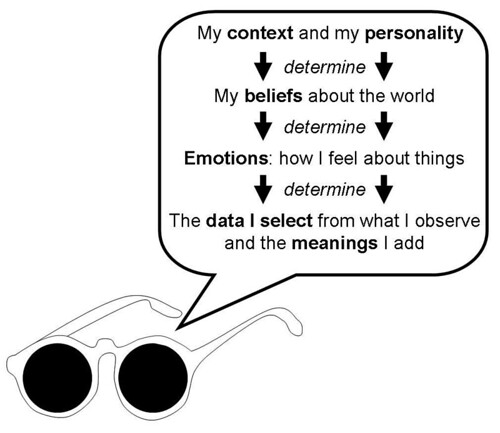No to the Non-sense of Measuring Culture!
Every now and then I meet HR managers who are keen on measuring culture and who claim to be working on the essential layer of their organization, the source-code so to speak.
To those managers I would like to say: you missed the point. In this article I have summarized why we should stop pretending that we can measure culture and propose an alternative instead.
Culture as a Pair of Glasses
We see the world as we are, not as it is. Another way of putting it is by saying ‘perception is reality‘. As the drawing below shows, culture is a sense making mechanism that works like a pair of glasses you are wearing. Pink-lensed glasses will make you feel happier than black-lensed glasses; that much is true.

What is less obvious, though, is that glasses of a certain color will make you see certain things more clearly and completely ignore other things; in other words, they determine the data you select.
So, as a starting point: culture is a sense making mechanism that determines our perception; culture IS the glasses. By the way, since taking off these glasses is not an option, none of us human beings is capable of looking AT the glasses, investigating and analyzing the components or comparing one pair to another.
Deceiving Belly Button Measurements
Then, what are we actually looking at when we measure culture with long and complex surveys? The answer? We are staring at our belly button. Here is what happens when we do that too often:
- The tool or survey which we choose as ‘the’ measuring instrument is already distorted by our perception to begin with;
- Based on this model we will distill dimensions which we assume are important to measure (You know, ‘assume’ – as in: “I am making an ASS out of U and ME”);
- Then these get translated to survey questions which supposedly reflect and measure these dimensions. As you can see there are a lot of bridges to cross and the distortions increase each time;
- Finally, in the majority of the organizations these surveys get distributed with a minimum of communication;
- As for the responses – they only get returned by a group of people who are willing to fill out and return the survey – again another filter on the population. All of these filters are unintentional, but they do occur;
- The next thing you know is that cultural surveys are interruptions that confuse the hell out of people. How would you react when a survey comes falling out of the sky that basically says: “please fill out this awkward questionnaire and we will push you in a stereotype category and tell your management about it.” Feel safer now? It gets people out of their comfort zone, that’s for sure, but what’s the benefit and will people respond truthfully – swear to God – what they feel and think?
We simplify the world into the dimensions of the survey (that part is OK – it’s called ‘focus‘) and we desperately try to make cause-and-effect relationships with these dimensions (this is the not-OK part – it’s called ‘stereotyping‘).
Not only will you be restricted to measure what you want to measure, you will also push the organization into the forced ranking of your statements and purge any other cause-and-effect relationship.
OK Smartass, What’s the Alternative?
Organizational change practitioners should ask themselves whether they are really that low on trust that they need a survey to justify an organizational change program? What’s wrong with starting from a vision and a strategy? The mechanism behind implementing a strategy is exactly the same, but the intent is different. A strategy also molds reality into “We see the world as we are“, but by implementing a strategy we co-create the future state instead of manipulating people into categories.
Second, managing organizational change is about getting people out of their comfort zone, but never ever without providing them a platform of psychological safety. And there’s a million ways to do that – although the best way is to do nothing, i.e. to shut up, listen and acknowledge receipt of what people tell you. Feeding them back what you have understood is an essential part of providing psychological safety.
The next step is called integrity, i.e. acting on their feedback (and letting them know that you are). And then – only then will people be ready to get on board (that is: because they choose to, not because they have to).
There Is No Outside
Another awkward thing is that organizations who want to do cultural surveys use a lot of ‘they‘, ‘them‘, ‘those people‘ and ‘over there‘ words when referring to their own organization. Karl Marx referred to this as alienation, and I would add that this is a behavior and not a circumstance.
Also Heidegger described this phenomenon quite precise when he referred to ‘Das Man’ (‘The They‘). My most favourite way of countering this is by telling that there is no outside (N° 10 of Senge’s Laws of Systems Thinking).
The point I’m trying to make here is that our inability to measure culture does not prevent us from creating one. And it’s really simple:
- as Ghandi said, be the change you want to see in the world;
- shut up, listen and acknowledge feedback,
- walk your talk.
Deceivingly simple? Yes.
Darn difficult? Indeed. Because you’re gonna get naked, vulnerable and hurt.


Pingback: Making Culture is No Rocket Science | Reply-MC()